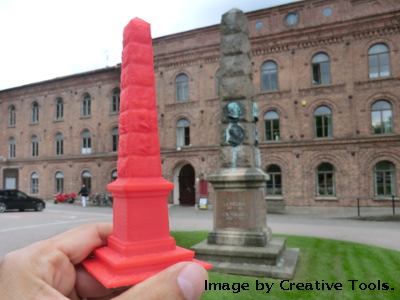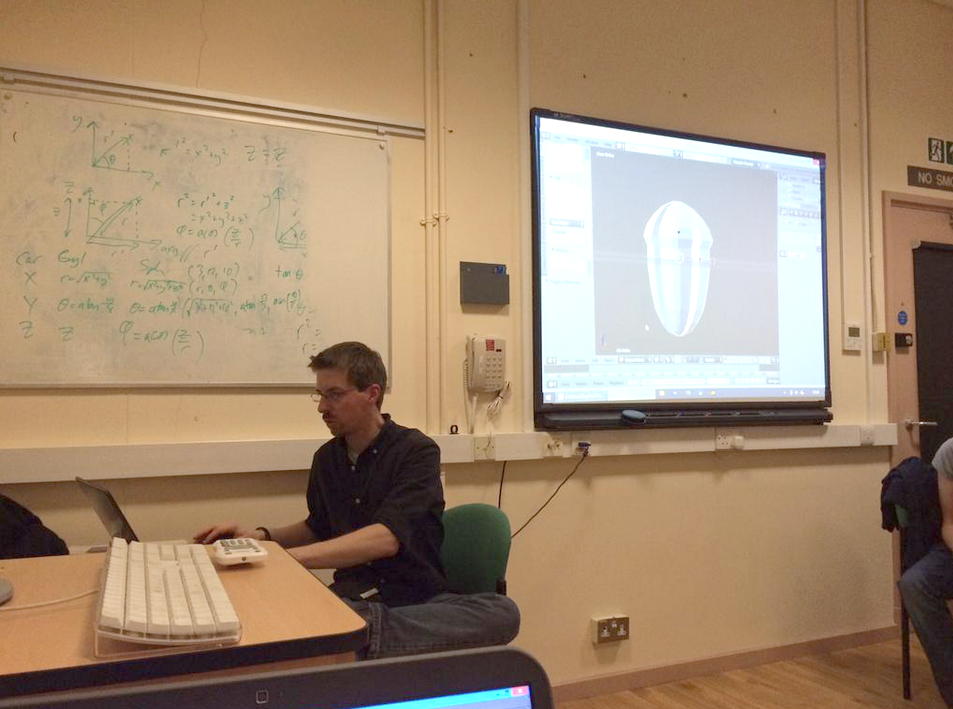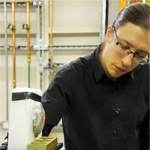Open source tomography training kicks off at Bristol
Posted on 8 June 2016
Open source tomography training kicks off at Bristol
 By Russell Garwood, Software Sustainability Institute Fellow and 1851 Research Fellow/Lecturer at the University of Manchester.
By Russell Garwood, Software Sustainability Institute Fellow and 1851 Research Fellow/Lecturer at the University of Manchester.
The 10th and 11th of February 2015 saw two days of training on using software for tomographic reconstruction for earth scientists at the University of Bristol. Software Sustainability Institute fellow Russell Garwood outlines the rationale behind the meeting and reports from the Institute-sponsored training courses.
The world of computerised tomography (CT) scanning is an exciting place to be. The advent of microtomography, a high-resolution form of scanning, allows researchers to look non-destructively inside an enormous variety of objects. From materials science and medicine to engineering and Egyptology, micro-CT is opening new avenues of research of which scientists could only have dreamed a few decades ago. Such scanners only provide grayscale slice images that show the cross-section of an object; however, these slices are relatively rarely the end of the line in any given study.
Usually, digital visualisation and/or quantification of the datasets are required. For this, software provides the primary tools. Many packages for visualising CT data exist, but most of the widely-used software packages are very expensive. This is at odds with increasingly cheap and accessible CT scanners, and free (albeit peer-reviewed) access to synchrotron X-ray sources. Software prices — rather than access to scanners — are becoming the primary barrier to widespread adoption of micro-CT in fields and parts of the world where research money is limited. Open source or free software is available — some of it coded for operability on low-powered (e.g. SPIERS) PCs further reducing the cost barrier towards adopting tomography as a mainstream approach, but awareness in the community is low. And because CT suites generally have access to proprietary packages, few provide training in open source packages.

Image by Russell Garwood/Imran Rahman
A key aim of Russell’s fellowship is to provide training and support in these free approaches, lessen the learning curve, incentivise the application of these approaches, and improve the accessibility and sustainability of these packages by building up a user community. This kicked off recently at the University of Bristol, with a series of courses on open source packages in addition to the commercial package Avizo. Palaeontologist Imran Rahman, an 1851 Research Fellow in the Department, reports “The 3-D visualisation workshop at Bristol attracted a large and diverse audience of students, staff and visitors, including researchers from a range of disciplines across the Earth Sciences. It was particularly valuable training for the Palaeobiology MSc students, a number of whom are about to commence projects that will utilise some of the techniques that were covered in the workshop, and this event provided a comprehensive yet accessible introduction to 3D visualisation that will greatly aid their future research.”
The first course on open source software gave an overview of Blender, taught by Stephan Lautenschlager at the University of Bristol (see image above), and aided by Russell, where a group of Earth Scientists (primarily palaeontologists) were led through workflows for ray-tracing, box modelling, and creating textures/materials for meshes with the software. The next day, Mark Sutton, from Imperial College, and Russell led a course on using SPIERS to mesh and visualise specimens from CT scanned slices. Tom Davies, the palaeontology lab manager at the University of Bristol, comments: “This training was very relevant to students and researchers in our department working on a range of projects from palaeontology to volcanology. The session was extremely useful in demonstrating the potential of the software and, in particular, tools such as defining masks and creating different surfaces for visualisation that are directly comparable to techniques we regularly apply on expensive, licensed software. Having the ability to apply such techniques in a freeware program will enable students to work on projects from their own computers rather than having to book onto a limited number of machines. From individuals that spoke to me after the event, people were impressed by the potential usefulness of the software, and the session had value both for individuals that had tried experimenting with the software previously as well as for individuals working in other areas who wish to explore possible future avenues for research.”
Tom concluded: “Built around this session we ran a wider ranging 3D workshop over two days that gave an opportunity for students to learn a range of software packages for achieving results from 3D data including Avizo, Blender and SPIERS. In combination, these sessions have taught our students skills covering visualisation, animation, and model creation that will be directly used in MSc thesis projects.“
Through courses such as this, the Software Sustainability Institute is supporting training which would otherwise not exist. The use of open source software, as well as reducing cost barriers for many researchers, encourages reproducible research in micro-CT and helps build a community using these free tools — hence enhancing the longevity of the packages.

